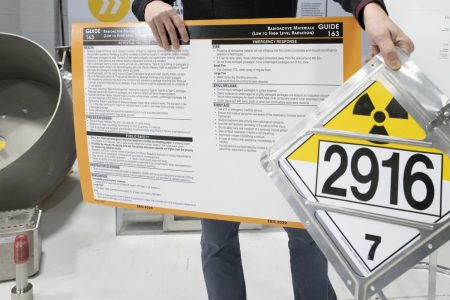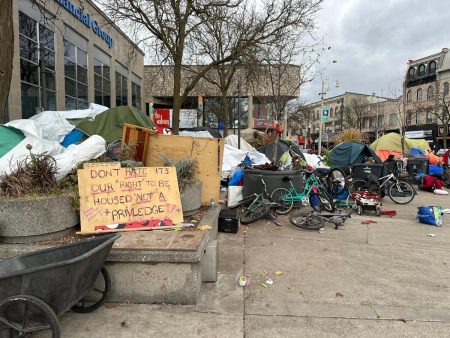From rumours about tunnels for bootlegging to hiding draft dodgers, Susan Ratcliffe talks truth versus fiction
Tunnels run all through Guelph’s underground, connecting downtown, all through the ward, used for smuggling bootleg alcohol and a intelligent escape route for mobsters like Al Capone.
These are a number of the tales Susan Ratcliffe has been informed, and rumours many Guelphites have doubtless heard over time. However are all of them true?
Ratcliffe is a neighborhood heritage advocate and has been offering historic strolling excursions for the Guelph Arts Council since 1987. Thursday night she spoke to a packed crowd on the predominant department of the Guelph Public Library to straighten out the info in relation to Guelph’s underground tunnels.
In her strolling excursions, some of the frequent questions is “can we see the tunnels?”
“It’s a very odd question given that Guelph is built on bedrock,” she mentioned. “Until there’s a new library, we have no underground parking because of that.”
Probably the most infamous of the rumours can be that the Sleeman brothers smuggled beer from the Albion to the Basilica throughout Prohibition utilizing underground tunnels.
Ratcliffe noticed the tunnel on a tour of the Albion in 2015. It does exist – nevertheless it’s solely a water pipe concerning the measurement of a dinner plate.
Beer was made within the basement of the Albion from spring water beginning in 1856. The water got here from a spring beneath the Basilica of Our Girl, and the tunnel connecting them is on the backside of the steps contained in the Albion. It’s since been cemented shut.
There have been, nonetheless, bootlegging tunnels working from the Silver Creek Brewery, began by John H. Sleeman in 1851, to simply exterior the Manor.
“Beer was carried in unlabelled bottles and farmer’s wagons and smuggled,” she mentioned. “When they got to the other side, the beer was added, or the beer was sold as medicine.”
Different rumours embrace tunnels working beneath Heritage Corridor related to the Underground Railroad (there aren’t), tunnels working beneath the Ignatius Centre to cover draft dodgers.
Within the early 1918, the Ignatius grounds had been used to coach Roman Catholic clergymen. These males had been excused from conscription, and on the time, folks believed they had been hiding draft dodgers in tunnels beneath the grounds. However Ratcliffe mentioned there have been no tunnels, nor draft dodgers.
There have been, nonetheless, some tunnels that had been misplaced over time.
There have been tales of tunnels working via the Ward used for bootlegging within the Nineteen Thirties, and in 1936 the police raided a big nonetheless (an enormous vat that would produce whisky).
The 5 tanks sitting exterior the Spring Mill Distillery was once underground, she mentioned.
Years in the past, the supervisor of the Sleeman museum seen a bump within the flooring, and picked up the carpet to discover a doorway to an underground tunnel the place they discovered the tanks, although they might have simply been used for lacquer for the tractors relatively than alcohol throughout Prohibition.
What about rumours of escape routes? There’s some fact to them, based on Ratcliffe.
The Paradise Gardens that later turned the Desert Inn was owned by the Guelph mafia, she mentioned. There was an escape tunnel from there that led to the mausoleum on the Woodlawn Cemetery.
Writer Jerry Prager writes in certainly one of his books of a tunnel mafia members used to flee from the Desert Inn to the Mausoleum, the place escapees may climb right into a double layered casket and “live again” in one other place.
These caskets had been invented by Buffalo mob boss Stafano ‘The Undertaker’ Magaddino. Whereas there’s no report of Al Capone utilizing the tunnels (and even being in Guelph), it’s believed the caskets performed a task within the disappearance of gangster and whisky bootlegger Rocco Perri, who typically will get confused for Capone.
“And then there were tunnels from Imperial Tobacco next door to the Desert Inn so they could smuggle out cigarettes,” she mentioned. When it was being demolished, these tunnels had been discovered.
There have been horse tunnels close to the Guelph Farmers’ Market as effectively, the doorway of which might be behind the butterfly mural off Gordon Road. It went all the way in which up from Woodlawn to the U of G, and was used to convey horses and cattle into the showroom for exhibitions on the Winter Truthful, a giant occasion held from 1889 to 1922.
“It’s all gone now,” she mentioned. Ratcliffe mentioned when a brand new metropolis corridor was being constructed, Counc. Leanne Caron requested if they may filter the tunnel and let folks use them, however contractors mentioned it was an excessive amount of of a legal responsibility, so that they had been crammed in.
Throughout excavation for the brand new library, tunnels had been additionally discovered beneath the Baker Road parking zone. The tunnels had a type of conveyor belt and had been used to maneuver objects between factories like Raymond Stitching and the Guelph Creamery. They weren’t sufficiently big for folks to stroll via, although.
The tunnels had been taken out throughout excavation.
It was additionally a former burying floor from 1827 to 1854. When it closed, our bodies had been moved to the Woodlawn cemetery, although some had been nonetheless discovered on the Baker Road website throughout excavation. Ratcliffe famous the our bodies had been from the burial grounds, not the tunnels.
Do we have now any tunnels that haven’t been sealed off?
We do, on the Ontario Reformatory.
There’s a tunnel underground from the executive constructing to the mechanical constructing, used for storage, meal supply and extra. It’s a couple of kilometre lengthy, with completely different varieties of labor areas inside. It additionally supplied entry to the jail, and guards would use the vertical exits to maneuver round and to return out “any place there was trouble.”
There are additionally tunnels for underground streams like Pond Creek and a Silvercreek (a portion of which was buried within the Fifties), and wind testing tunnels at RWDI on Southgate Drive.
Ratcliffe’s discuss was a part of the Guelph Public Library’s Historical past Lives Right here speaker collection. The subsequent one might be held on Nov. 12.









